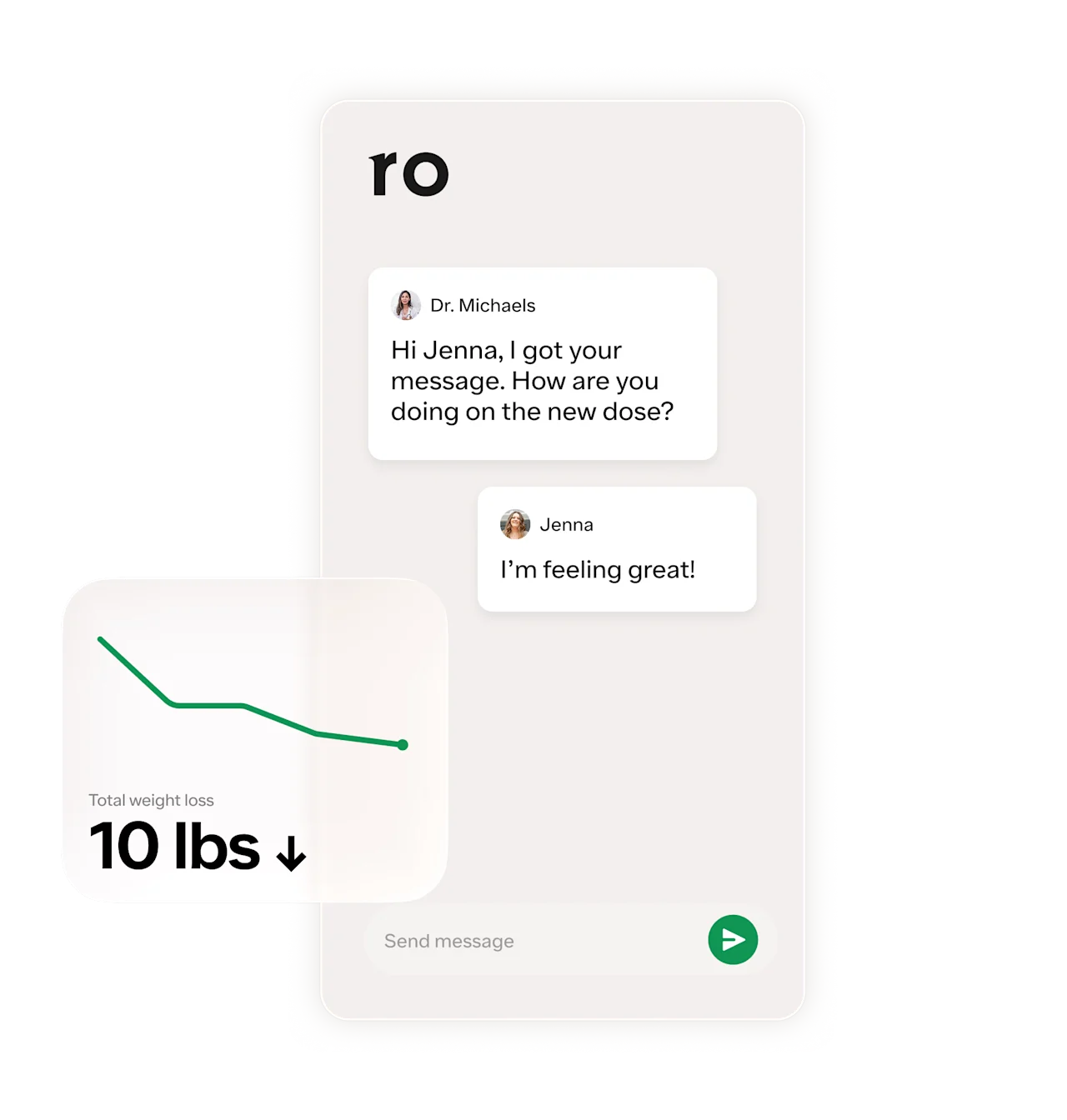Key takeaways
Fiber can support weight loss by increasing satiety hormones, slowing eating rate, and decreasing inflammation.
The recommended intake for total fiber is 28-30 grams per day, but your ideal amount depends on personal health status and goals.
Here's what we'll cover
Here's what we'll cover
Here's what we'll cover
Key takeaways
Fiber can support weight loss by increasing satiety hormones, slowing eating rate, and decreasing inflammation.
The recommended intake for total fiber is 28-30 grams per day, but your ideal amount depends on personal health status and goals.
If fiber had a claim to fame, it would be its benefits for digestion and gut health. But fiber is also touted as a key nutrient for weight management, along with protein, a macronutrient. With that in mind, if you’re looking to shed pounds and prevent excess weight gain, you might wonder, can fiber help you lose weight? And if so, how does fiber help with weight loss?
As it turns, the nutrient can certainly lend a hand. Here, learn how fiber can support your weight loss goals, plus how much fiber to eat per day to lose weight.
What is fiber?
Fiber is a type of carbohydrate that’s non-digestible, meaning it’s not digested or absorbed in the gastrointestinal tract. It’s found in many plant foods—and is one of the many reasons why such foods can be particularly good for you. However, not all fiber is equal.
There are two types: soluble and insoluble fiber. As the name suggests, soluble fiber is soluble (i.e. dissolvable) in water. When this type of fiber interacts with H2O in the GI tract, it forms a sticky gel. On the other hand, insoluble fiber doesn’t dissolve in water, so it stays intact as it journeys through your intestines.
Because of the differences in dissolvability, soluble and insoluble fiber have different benefits in the body. The gelling effect of soluble fiber helps support healthy cholesterol levels, blood sugar control, and—as we’ll explore in a bit—weight loss and satiety. In contrast, insoluble fiber helps bulk the stool, making it easier to pass and potentially reducing constipation.
How does fiber help with weight loss?
If weight loss is your goal, the typical first step in your slim-down journey is to decrease your daily caloric intake by 500-750 calories. Swapping high-calorie foods with items rich in fiber and protein can help you lose weight, as they both tend to be lower in calories and support weight loss through a variety of different ways.
But you’re here to learn about fiber and its influence on the scale in particular. So, let’s get to it. Here are three ways that fiber can help with weight loss:
Fiber increases satiety hormones
Fiber, particularly soluble fiber, promotes satiety (i.e. the feeling of fullness). When soluble fiber enters the GI tract, it becomes fermented by gut bacteria, which produces compounds called short-chain fatty acids (SCFAs). These SCFAs increase levels of peptide YY, glucagon-like-peptide-1 (yes, that GLP-1), and cholecystokinin—all of which are hormones that promote fullness. At the same time, fiber reduces ghrelin, the hunger hormone. These effects can help you feel satisfied, leading you to stop eating sooner and less overall. As a result, you’re more likely to eat fewer calories, which can support overall weight loss.
Low-fiber foods—e.g. white bread, sugary cereals, packaged snacks, and processed meats—generally have the opposite effect. Since they’re low in the macronutrient, they’re more likely to leave you feeling unsatisfied, increasing your odds of consuming more food and calories.
Fiber makes you eat slowly
Foods high in overall fiber tend to have a tough texture. In other words, you may need to chew them more than you would when eating low-fiber foods. Consider brown vs. white rice: Brown rice, which has more fiber, is notably firmer than its white counterpart, which has less fiber. So, when you eat brown rice, you’ll likely need to chew more before you can swallow it.
The more time you need to spend chewing, the slower you might eat. This can potentially reduce how much food (and total calories) you consume, paving the way for weight loss. What’s more, when you eat slowly, your body has more time to send satiety signals to your brain to let it know you’re full.
Fiber supports gut bacteria diversity
As mentioned, soluble fiber becomes fermented by bacteria in the gut. This happens when said bacteria metabolizes, or breaks down, the fiber. The process produces SCFAs, increasing PYY, GLP-1, and CCK—which, again, are satiety hormones that reduce appetite. This process also boosts the secretion of leptin, another hormone that decreases appetite; it works by blocking neural pathways related to appetite.
But that’s not all. Soluble fiber feeds beneficial bacteria in the GI tract, paving the way for an overall balanced, healthier gut. This is noteworthy because the opposite—an imbalanced gut—can increase inflammation, a contributing factor of weight gain and obesity.
Do fiber supplements help with weight loss?
If you’re trying to lose weight but having a hard time eating fiber-rich foods, taking fiber supplements might be helpful, notes Johanna P. Salazar, MS, RDN. You can typically find them at grocery stores, drugstores, and health food stores in the form of pills, powders, and gummies.
In a review of 12 clinical trials, researchers found that supplementing with soluble fiber can support weight loss in people with obesity or overweight. Another study found that the combination of fiber supplements and calorie restriction can promote weight loss in the same patient population. But as the researchers note, fiber supplements aren’t a replacement for whole fiber-rich foods (think: fruits, vegetables, whole grains). Salazar echoes this notion, sharing that “the best type of fiber is the one that comes from the foods you eat.”
Additionally, as with other types of supplements, fiber supplements are not approved or regulated by the Food and Drug Administration (FDA), Salazar says. This means they haven’t been tested for efficacy and safety before hitting the market. So, if you’re interested in taking fiber supplements, it’s important to consult your healthcare provider before adding them (or anything new, for that matter) to your routine.
Another thing to keep in mind: “When taking fiber supplements, stay hydrated,” Salazar advises. “Too much fiber without sufficient water intake can lead to constipation.”
How much fiber to eat per day to lose weight
Whether or not you’re trying to lose weight, aim to consume 28–30 grams of fiber per day, Salazar says. This is the overall recommended amount associated with good health, as a healthy intake of fiber is linked to weight loss and a lower risk of chronic health conditions, such as heart disease and type 2 diabetes (which, coincidentally, are also linked to excess weight).
But take note: The daily recommended intake for fiber isn’t a hard-and-fast rule, so try not to stress too much about meeting those numbers. It’s a general suggestion, as “fiber needs vary with age, activity level, and water intake,” Salazar says. Your best bet is to work with a dietitian or another healthcare provider to meet your personalized needs; they can let you know how much fiber per day to help lose weight is necessary.
It’s also worth noting that a whopping 95% of Americans already don’t eat enough fiber per day, so even a small increase in your fiber intake can be beneficial. Plus, it can take time to incorporate fiber-rich foods into your diet, so it’s okay to do so slowly.
Otherwise, if you’re unsure where to start and weight loss is on your radar, try to increase your intake of foods high in soluble fibers. Examples include:
Oats
Barley
Fruits
Beans
Legumes (e.g. peas)
Most root vegetables, such as carrots
How much fiber do you need while taking weight loss medication?
Can fiber help you lose weight even if you’re taking weight loss medication, such as Wegovy or Zepbound? It sure can. Here’s why: Wegovy and Zepbound are known as glucagon-like peptide-1 (GLP-1) receptor agonists. These medications mimic the hormone GLP-1, which is released by SCFAs in the gut after you eat. As mentioned earlier, fiber also increases GLP-1, so increasing your fiber intake while taking a weight loss medication, such as a GLP-1, may boost your overall results.
All that said, even when taking weight loss medication, you can still aim for the recommended 28–30 grams per day, according to Salazar. Again, the ideal amount depends on many factors, including your age, activity level, and water intake, as well as your specific needs and goals. Working with a registered dietitian or another healthcare provider can help you find your personalized amounts, says Salazar. And this is something you can get through Ro, which offers ongoing care and support to help you navigate your weight loss journey.
Wegovy Important Safety Information: Read more about serious warnings and safety info.
Zepbound Important Safety Information: Read more about serious warnings and safety info.
Bottom line on fiber for weight loss
Fiber is particularly satiating, so it can promote weight loss by helping you eat less food (and, therefore, fewer calories). What’s more, eating fiber for weight loss can be similar to eating fiber for general health, as you should still aim for the recommended 28–30 grams a day regardless of your weight goals. Just remember to drink plenty of fluids to avoid feeling backed up and to consult a healthcare provider if you have any questions or need help navigating any diet changes.
DISCLAIMER
If you have any medical questions or concerns, please talk to your healthcare provider. The articles on Health Guide are underpinned by peer-reviewed research and information drawn from medical societies and governmental agencies. However, they are not a substitute for professional medical advice, diagnosis, or treatment.
References
Bulsiewicz, W. J. (2023). The importance of dietary fiber for metabolic health. American Journal of Lifestyle Medicine, 17(5), 639 – 648. doi: 10.1177/15598276231167778. Retrieved from https://www.ncbi.nlm.nih.gov/pmc/articles/PMC10498976/
Dahiya, D. K., Renuka, Puniya, M., Shandilya, U. K., et al. (2017). Gut Microbiota Modulation and Its Relationship with Obesity Using Prebiotic Fibers and Probiotics: A Review. Frontiers in Microbiology, 8, 563. doi: 10.3389/fmicb.2017.00563. Retrieved from https://www.ncbi.nlm.nih.gov/pmc/articles/PMC5378938/
Dongen M. V., Kok F. J., & de Graaf, C. (2011). Eating rate of commonly consumed foods promotes food and energy intake. Appetite, 56(1), 25-31. doi: 10.1016/j.appet.2010.11.141. Retrieved from https://www.sciencedirect.com/science/article/pii/S0195666310006884?via%3Dihub
Jenko Pražnikar, Z., Mohorko, N., Gmajner, D., et al. (2023). Effects of Four Different Dietary Fibre Supplements on Weight Loss and Lipid and Glucose Serum Profiles during Energy Restriction in Patients with Traits of Metabolic Syndrome: A Comparative, Randomized, Placebo-Controlled Study. Foods (Basel, Switzerland), 12(11), 2122. doi: 10.3390/foods12112122. Retrieved from https://www.ncbi.nlm.nih.gov/pmc/articles/PMC10253086/
Kelly, R. K., Calhoun, J., Hanus, A., et al. (2023). Increased dietary fiber is associated with weight loss among Full Plate Living program participants. Frontiers in Nutrition, 10, 1110748. doi: 10.3389/fnut.2023.1110748. Retrieved from https://www.ncbi.nlm.nih.gov/pmc/articles/PMC10150096/
Keramat, S. A., Alam, K., Rana, R. H., et al. (2021). Obesity and the risk of developing chronic diseases in middle-aged and older adults: Findings from an Australian longitudinal population survey, 2009-2017. PloS One, 16(11), e0260158. doi: 10.1371/journal.pone.0260158. Retrieved from https://www.ncbi.nlm.nih.gov/pmc/articles/PMC8594821/
Kim, J. Y. (2021). Optimal Diet Strategies for Weight Loss and Weight Loss Maintenance. Journal of Obesity & Metabolic Syndrome, 30(1), 20–31. doi: 10.7570/jomes20065. Retrieved from https://www.ncbi.nlm.nih.gov/pmc/articles/PMC8017325/
McRorie, J. W., Jr (2015). Evidence-Based Approach to Fiber Supplements and Clinically Meaningful Health Benefits, Part 1: What to Look for and How to Recommend an Effective Fiber Therapy. Nutrition Today, 50(2), 82–89. doi: 10.1097/NT.0000000000000082. Retrieved from https://www.ncbi.nlm.nih.gov/pmc/articles/PMC4415962/
Obradovic, M., Sudar-Milovanovic, E., Soskic, S., et al. (2021). Leptin and obesity: Role and clinical implication. Frontiers in Endocrinology, 12, 585887. doi: 10.3389/fendo.2021.585887. Retrieved from https://www.ncbi.nlm.nih.gov/pmc/articles/PMC8167040/
Salleh, S. N., Fairus, A. A. H., Zahary, M. N., et al. (2019). Unravelling the Effects of Soluble Dietary Fibre Supplementation on Energy Intake and Perceived Satiety in Healthy Adults: Evidence from Systematic Review and Meta-Analysis of Randomised-Controlled Trials. Foods (Basel, Switzerland), 8(1), 15. doi: 10.3390/foods8010015. Retrieved from https://www.ncbi.nlm.nih.gov/pmc/articles/PMC6352252/
Thompson S. V., Hannon B. A., An, R., et al. (2017). Effects of isolated soluble fiber supplementation on body weight, glycemia, and insulinemia in adults with overweight and obesity: a systematic review and meta-analysis of randomized controlled trials. The American Journal of Clinical Nutrition, 106(6), 1514-1528. doi: 10.3945/ajcn.117.163246. Retrieved from https://ajcn.nutrition.org/article/S0002-9165(22)02702-2/fulltext
U.S. Food & Drug Administration (FDA). (2023). Facts about dietary supplements. Retrieved from https://www.fda.gov/news-events/rumor-control/facts-about-dietary-supplements
Quagliani, D., & Felt-Gunderson, P. (2016). Closing America's Fiber Intake Gap: Communication Strategies From a Food and Fiber Summit. American Journal of Lifestyle Medicine, 11(1), 80–85. doi: 10.1177/1559827615588079. Retrieved from https://www.ncbi.nlm.nih.gov/pmc/articles/PMC6124841/













